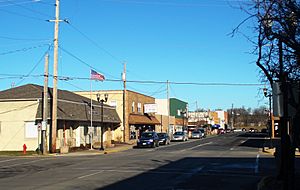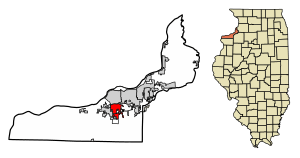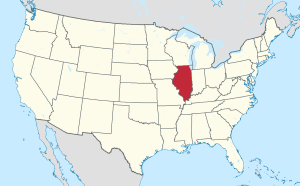Milan, Illinois facts for kids
Quick facts for kids
Milan
|
|
|---|---|
 |
|

Location of Milan in Rock Island County, Illinois.
|
|

Location of Illinois in the United States
|
|
| Country | United States |
| State | Illinois |
| County | Rock Island |
| Area | |
| • Total | 6.85 sq mi (17.74 km2) |
| • Land | 6.25 sq mi (16.20 km2) |
| • Water | 0.59 sq mi (1.54 km2) |
| Population
(2020)
|
|
| • Total | 5,097 |
| • Density | 814.87/sq mi (314.62/km2) |
| Time zone | UTC-6 (CST) |
| • Summer (DST) | UTC-5 (CDT) |
| ZIP Code(s) |
61264
|
| Area code(s) | 309 |
| FIPS code | 17-49009 |
| Wikimedia Commons | Milan, Illinois |
Milan (pronounced MY-lin) is a village in Rock Island County, Illinois, United States. In 2020, about 5,097 people lived there.
This village is very close to the Quad Cities, which are a group of cities in both Illinois and Iowa.
Contents
History of Milan
Milan is located on the Rock River in northwest Illinois. This spot is about 4 miles upstream from where the Rock River flows into the Mississippi River.
Early Native American Village
Long ago, this area was home to a large Native American village called Saukenuk. It was a major settlement for the Sauk and Fox tribes. In fact, it was once the second-largest Native American village in North America.
How Milan Got Its Name
In 1837, the village area was first planned out. It was located along the path of the Hennepin Canal. At first, people called this planned area "Hampton." This was not the same Hampton that is about 13 miles away on the Mississippi River.
The people who planned "Hampton," George Camden and Franklin Vandruff, sold land along the Rock River. There was a small creek called Mill Creek that flowed into the Rock River. Industries like wool-carding (making wool ready to be spun into yarn) and making "pearl" buttons from river clam shells grew here. Because of these mills, the village was renamed Camden Mills by 1841. Later, it became Milan.
Milan also has "sister cities" in other states like Missouri, Tennessee, and Michigan.
Geography of Milan
Milan is located at coordinates 41.446333 degrees North and 90.565487 degrees West.
Land and Water Areas
According to information from 2010, Milan covers a total area of about 6.46 square miles (16.74 square kilometers). Most of this area is land. About 5.87 square miles (15.20 square kilometers) is land. The rest, about 0.59 square miles (1.54 square kilometers), is water.
Population Information
| Historical population | |||
|---|---|---|---|
| Census | Pop. | %± | |
| 1880 | 845 | — | |
| 1890 | 692 | −18.1% | |
| 1900 | 719 | 3.9% | |
| 1910 | 727 | 1.1% | |
| 1920 | 850 | 16.9% | |
| 1930 | 888 | 4.5% | |
| 1940 | 1,210 | 36.3% | |
| 1950 | 1,737 | 43.6% | |
| 1960 | 3,065 | 76.5% | |
| 1970 | 4,873 | 59.0% | |
| 1980 | 6,371 | 30.7% | |
| 1990 | 5,831 | −8.5% | |
| 2000 | 5,348 | −8.3% | |
| 2010 | 5,099 | −4.7% | |
| 2020 | 5,097 | 0.0% | |
| U.S. Decennial Census | |||
In 2000, Milan had 5,348 people living there. There were 2,310 households. A household is a group of people living in the same home.
Population Details
The population was spread out by age. About 23.3% of the people were under 18 years old. About 14.9% were 65 years old or older. The average age in the village was 38 years.
Economy of Milan
Milan is an important place for business.
Major Businesses
The village is home to the John Deere North American Parts Distribution Center. This is one of the largest warehouses in the entire world. It handles many parts for John Deere farm and construction equipment.
Before 2003, a company called Eagle Food Centers had its main office in Milan.
Transportation in Milan
Getting around Milan and the nearby areas is easy.
Bus Services
Quad Cities MetroLINK provides bus service. These buses connect Milan to many different places across the Quad Cities area.
Notable People from Milan
Many interesting people have connections to Milan.
- Ken Bowman: He was a professional football player. He played as a center and won three NFL championships with the Green Bay Packers. Ken was born in Milan.
- Ethan Happ: He is a basketball player who played for the Wisconsin Badgers.
- Ralph Fletcher Seymour: He was a book publisher, an artist, and an author.
- Joe Frisco: He was a jazz dancer, a vaudeville performer, and a comedian.
- Therese Anne Fowler: She is a talented author and a television producer.
See also
 In Spanish: Milan (Illinois) para niños
In Spanish: Milan (Illinois) para niños

